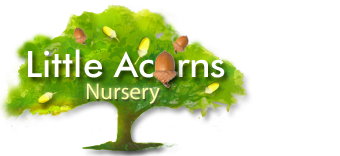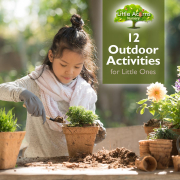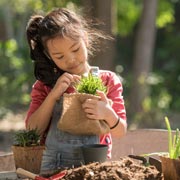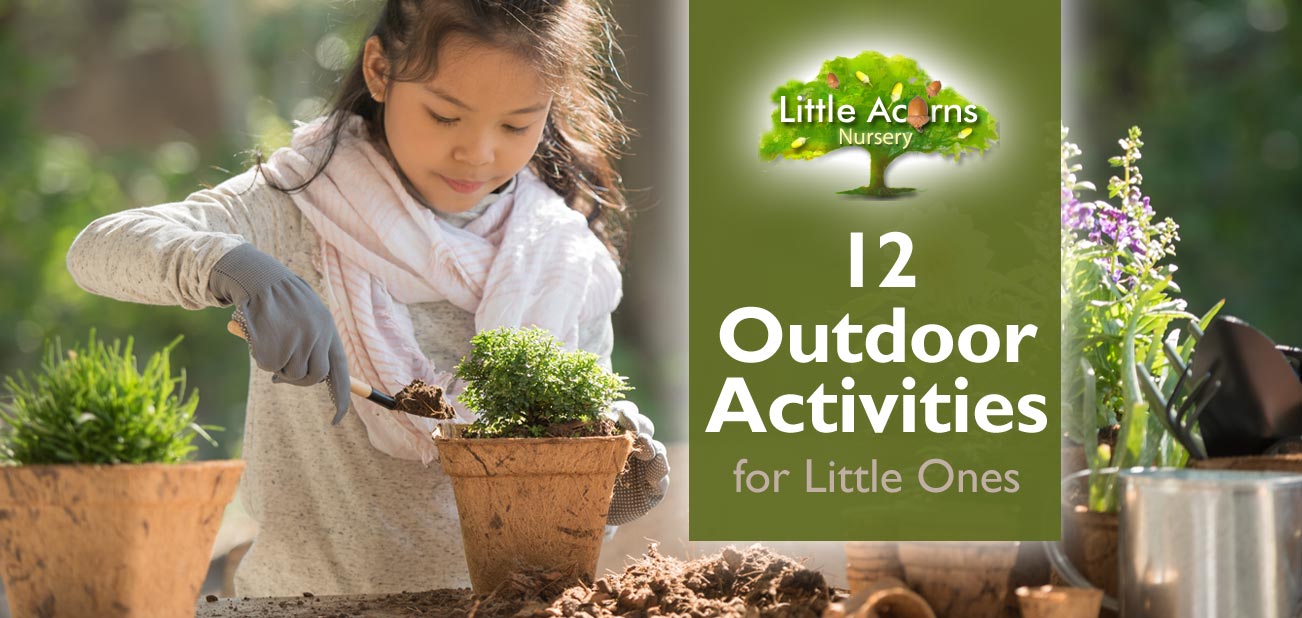
Our last post described the huge number of benefits of outdoor play for children in their early years. With that in mind, today’s post highlights twelve excellent outdoor play activities that young children can enjoy. With spring all but upon us at time of writing, children will be able to get outdoors more and more in the coming weeks and months. Our activity suggestions are fun, educational, will teach children new skills and will get them out into the healthy fresh air too. Our ideas below are mostly of the more natural variety too, so need not cost anything. Take a look …
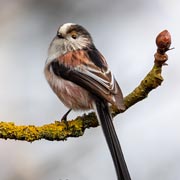 1. Bird spotting
1. Bird spotting
Teaching children to spot birds will really help them to appreciate wild creatures. They can simply watch for them in the park, on the balcony, in the garden or out in the country. Putting out some bird food and waiting patiently and quietly out of sight will help, of course. If children have made home-made bird feeders — even better! It’s more educational if they can view a UK bird book or app so they can identify the types of birds that they see. Maybe make them a list if they can read, or a pictorial reference sheet that they can tick off. Robins, sparrows, blackbirds, pigeons, doves and various types of tit are common in the UK, but there are many other types too. Here’s a handy list of the 19 most common British birds.
2. B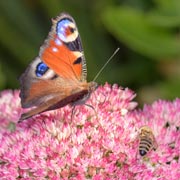 ee & Butterfly Spotting
ee & Butterfly Spotting
Similarly, bee and butterfly spotting is a wonderful activity for young children, although it relies more on there being an abundance of the right kind of flowers and plants growing nearby. Butterflies, bees and gentle hover flies will flock to plants like Buddleia, for example. They all generally like any flowering plants that are rich in nectar, scented and colourful. As we suggested for birds, perhaps parents or carers can print out pictorial reference for the different types that children may discover. Here’s a great reference for the different types of bee found in the UK and here’s a guide for UK butterflies.
 3. Search for Animal Tracks
3. Search for Animal Tracks
Continuing with our wildlife activity theme, another educational and interesting activity for little ones is to see if they can find animal tracks. This is best done when there is suitable habitat for paw prints and suchlike, for instance where there is soft earth, mud or sand nearby. It might be a good activity to do whilst out rambling (see #6 below). Perhaps search near a lake or river as many birds and animals will visit the water’s edge — or in snow if it’s winter. (N.B. such activities should be done under adult supervision for safety, of course).
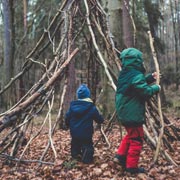 4. Make a Den
4. Make a Den
Once in the outdoors, whether in a garden, courtyard, park or countryside, children love building dens to ‘camp’ in. Building them is all part of the fun and they can be made with long sticks and foliage, a sheet draped over string tied between trees, or simply using a low-cost children’s tent or similar. Once erected, children will love using the den to use as a base, like their own ‘home in the wild’. Their imaginations can run riot and all manner of games, role-play and adventure can ensue.
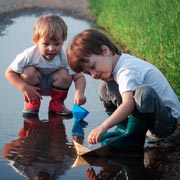 5. Float a Boat
5. Float a Boat
Little ones will love floating little boats on water (with supervision of a responsible adult for safety, of course). They’ll enjoy it even more if they have made the little boat or raft themselves. Boats can be made simply from folded paper (as in the photograph) or using little sticks, string and perhaps a little bit of a cloth for a sail. If there’s a stream, then even better — they can race their boats! Even a puddle, pond or paddling pool will do, though.
 6. Go on a Ramble
6. Go on a Ramble
A walk to around the local park, beside a local river, woods or countryside is one of life’s great free pleasures. The benefits of being out in nature are significant and numerous for children and adults alike. A ramble with Mum or Dad or another responsible adult will do wonders for a child’s physical and mental wellbeing. It’s also a wonderful chance for adventure, discovery, varied play — and fun!
 7. Get into Photography
7. Get into Photography
With cameras being a part of mobile phones and tablets these days, photography is easily accessible to little ones. It’s easy too … just preview, check the subject is in view and in focus, and press the button. And, if children get more interested, perhaps they could ask for a camera, whether new, second-hand or passed down when a relative upgrades. Children will love seeing the results when they take photos of flowers, insects, landscapes, trees, sunsets and anything that triggers their imagination in the outdoors. Who knows — it could even lead to a creative career!
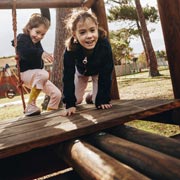 8. Obstacle Course
8. Obstacle Course
The opportunities for playing are infinite outdoors. Children will love running and climbing around an assault course. This could be formal (like in a playground) or using more rustic obstacles like trees, logs, inclines and suchlike. Obstacles courses outdoors are a great way to challenge children’s imaginations, skills like problem-solving and, of course, fitness, motor skills, balance and coordination. They could even do it in teams. It’s all great fun!
 9. Have a Picnic
9. Have a Picnic
Little ones love picnics! So, next time the sun is out and you’re taking your child(ren) out to the park, the countryside or even perhaps just to a garden, consider taking a picnic. Children can even be involved in preparing for one and will enjoy the sense of responsibility that goes with gathering everything that’s needed. Then, once outdoors, they’ll enjoy sitting on the picnic mat with the food, drink, fresh air and immersing themselves in the very ‘civilised’ thing that is the picnic!
10. Plant a Mini Garden
Planting seedlings, vegetables, plants or herbs in the garden is one of life’s simple pleasures for children and adults alike. It’s a relaxing and educational activity for children to enjoy outdoors. While a garden is ideal, containers or pots on a balcony, courtyard, patio or windowsill will suffice as plants need only be small. Supervising adults can help children to care for the plants and, in time, harvest flowers, herbs or vegetables from them. They will learn so many lessons by growing plants and food, including patience and empathy, and will get a great sense of achievement when they see the results. They will also have witnessed the magic of nature.
 11. Hunt for Mini Beasts
11. Hunt for Mini Beasts
Children can also search outdoors for mini beasts like woodlice, ants, beetles, ladybirds, centipedes, caterpillars, slow-worms and even earth worms. They need to be respectful of them and be gentle, however. After all, each is a living being with its own needs and feelings. So caring, adult supervision is always best around little creatures, particularly when children first learn about them. They will love getting to discover their tiny neighbours and perhaps even get to rescue any that occasionally get themselves into trouble, for example a bug that’s landed in a puddle or butterfly that’s in danger of getting caught in a web. A sense of empathy will naturally come from such activities.
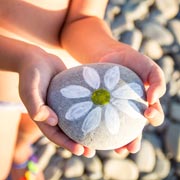 12. Get Creative with Rocks & Stones
12. Get Creative with Rocks & Stones
 Whether on the beach or in the garden, it’s surprising how creative children can be with stones and rocks! Stones can be painted with lovely patterns or images, perhaps combined with simple words or as part of a ‘stone story’. Bigger rocks can be piled one on top of the other to form sculptures — these look magical. Children will love these and other creative activities that they can take part in outdoors, with simple stones and rocks.
Whether on the beach or in the garden, it’s surprising how creative children can be with stones and rocks! Stones can be painted with lovely patterns or images, perhaps combined with simple words or as part of a ‘stone story’. Bigger rocks can be piled one on top of the other to form sculptures — these look magical. Children will love these and other creative activities that they can take part in outdoors, with simple stones and rocks.
Safety First
Outdoor Play at Little Acorns Nursery & Forest School (Clayton-le-Woods, Chorley)
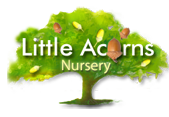 We have outstanding outdoor play areas at Little Acorns Nursery in Clayton-le-Woods, Chorley, Central Lancashire. We also have a wonderful Forest School for our under-fives. We have an Excellent Ofsted rating and an outstanding National-level nursery award. We’re near Clayton Green and Clayton Brook too, so will be perfect for you if you live or work in any of those areas and need the very best childcare for your child. Arrange a visit with your child or baby, so you can all look around. Alternatively, get in touch to ask any questions or simply apply for a nursery place if you’re ready to. We look forward to meeting you!
We have outstanding outdoor play areas at Little Acorns Nursery in Clayton-le-Woods, Chorley, Central Lancashire. We also have a wonderful Forest School for our under-fives. We have an Excellent Ofsted rating and an outstanding National-level nursery award. We’re near Clayton Green and Clayton Brook too, so will be perfect for you if you live or work in any of those areas and need the very best childcare for your child. Arrange a visit with your child or baby, so you can all look around. Alternatively, get in touch to ask any questions or simply apply for a nursery place if you’re ready to. We look forward to meeting you!
